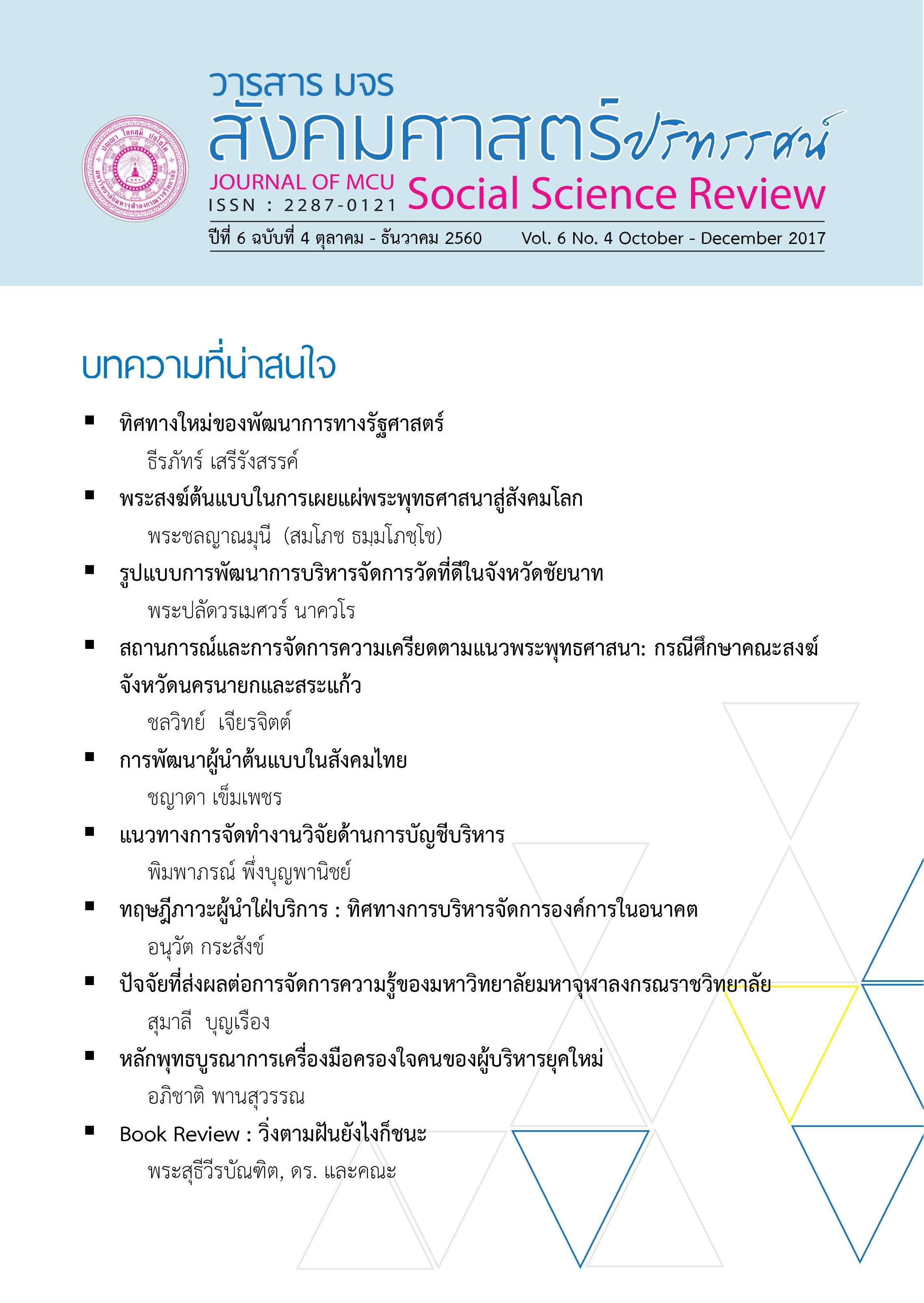รูปแบบการพัฒนาการบริหารจัดการวัดที่ดีในจังหวัดชัยนาท
คำสำคัญ:
การบริหารจัดการ, วัดในจังหวัดชัยนาทบทคัดย่อ
บทความเรื่อง “รูปแบบการพัฒนาการบริหารจัดการวัดที่ดีในจังหวัดชัยนาท” มีวัตถุประสงค์เพื่อ 1) ศึกษาสภาพทั่วไปในการบริหารจัดการวัดในจังหวัดชัยนาท 2) ศึกษาองค์ประกอบเกี่ยวกับการบริหารจัดการวัดที่ดีในจังหวัดชัยนาท 3) นำเสนอรูปแบบการพัฒนาการบริหารจัดการวัดที่ดีในจังหวัดชัยนาท ระเบียบวิธีวิจัยเป็นแบบผสานวิธี ระหว่างวิธีวิจัยเชิงคุณภาพ จากการวิเคราะห์เอกสาร และการสัมภาษณ์เชิงลึก จากผู้ให้ข้อมูลสำคัญ จำนวน 32 รูปหรือคน วิเคราะห์ข้อมูลโดยการวิเคราะห์ข้อมูลเชิงอรรถาธิบายและพรรณนาความ แล้วจึงสร้างรูปแบบเบื้องต้น ก่อนนำเสนอผู้เชี่ยวชาญจำนวน 12 รูปหรือคน ยืนยันรูปแบบอีกครั้งหนึ่งในการสนทนากลุ่มเฉพาะ และวิจัยเชิงปริมาณ เก็บข้อมูลจากแบบสอบถาม ซึ่งมีค่าความเชื่อมั่นทั้งฉบับเท่ากับ 0.981 จำนวน 162 ชุด กับกลุ่มตัวอย่างคือพระสงฆ์จังหวัดชัยนาท ซึ่งใช้วิธีการสุ่มแบบชั้นภูมิ วิเคราะห์ข้อมูลโดยใช้โปรแกรมสำเร็จรูปทางสังคมศาสตร์ด้วยคอมพิวเตอร์ สถิติที่ใช้คือค่าความถี่ ค่าร้อยละ ค่าเฉลี่ย และค่าเบี่ยงเบนมาตรฐาน
ผลการวิจัยพบว่า
1. สภาพทั่วไปในการบริหารจัดการวัดในจังหวัดชัยนาท พบว่า มีจุดแข็งคือมีการบริหารจัดการเป็นเอกภาพภายใต้การปกครองคณะสงฆ์ของเจ้าคณะระดับต่างๆ เจ้าอาวาสเป็นผู้ปกครองสูงสุด มีความรู้เป็นอย่างดี ส่วนจุดอ่อนคือ มีพระภิกษุสามเณรจำนวนน้อย บางวัดมีเพียงเจ้าอาวาสเพียงรูปเดียว บางวัดมีแต่พระที่ชราภาพ ทำให้การบำรุงรักษาวัดไม่เป็นระเบียบ สกปรก รกร้าง โบราณสถานเกินการชำรุดทรุดโทรมตามกาลเวลา โอกาสคือ จังหวัดชัยนาทเป็นจังหวัดที่มีพุทธศาสนิกชนจำนวนมาก เป็นเมืองพระพุทธศาสนาที่มีประวัติความเป็นมาอันยาวนาน มีพระเกจิ พระเถระที่มีคนนับถือจำนวนมาก มีศิลปวัฒนธรรมที่สอดคล้องกับพระพุทธศาสนา และประชาชนมีวิถีการดำเนินชีวิตตามแนวทางพระพุทธศาสนา อุปสรรคคือ จังหวัดชัยนาทมีความหลากหลายทางด้านวัฒนธรรม กระแสความนิยมของต่างประเทศเริ่มเข้ามาทำลายวัฒนธรรมอันดีงามของจังหวัด เด็กและเยาวชนขาดความรู้ความเข้าใจในวัฒนธรรมเดิมๆที่ปู่ย่าตายายเคยทำเอาไว้เป็นแบบอย่าง มักเปลี่ยนแปลงวัฒนธรรมใหม่จนกลายเป็นเทรนที่ผิดๆ
2. องค์ประกอบในการบริหารจัดการวัดที่ดีในจังหวัดชัยนาทนั้นประกอบด้วย 4 องค์ประกอบ 12 หลักการ ดังนี้ องค์ประกอบที่ 1 ด้านบำรุงรักษาวัด จัดกิจการ และ ศาสนสมบัติ ประกอบด้วย 3 หลักการสำคัญ คือ หลักการที่ 1 การจัดทำแผนยุทธศาสตร์การพัฒนาวัด หลักการที่ 2 พัฒนาวัดต้นแบบ อุทยานการศึกษาภายในวัด วัดพัฒนาตัวอย่าง หลักการที่ 3 จัดทำเครื่องมือในการเก็บรักษาศาสนสมบัติของวัดที่มีประสิทธิภาพ องค์ประกอบที่ 2 ด้านการปกครองบรรพชิตและคฤหัสถ์ ประกอบด้วย 3 หลักการสำคัญ คือ หลักการที่ 1 จัดตั้งสำนักงานเจ้าอาวาสแบบครบวงจร หลักการที่ 2 พัฒนาพระสงฆ์นักปกครอง หลักการที่ 3 คือ สร้างศาสนทายาทต้นแบบ องค์ประกอบที่ 3 ได้แก่ ด้านการศึกษาอบรมและสั่งสอนประกอบด้วยหลักการสำคัญๆ 3 ด้านคือ หลักการที่ 1 จัดตั้งโรงเรียนพระปริยัติธรรมแผนกธรรมและบาลี หลักการที่ 2 คือ ส่งเสริมและสนับสนุนการศึกษาตลอดชีวิต หลักการที่ 3 คือ พัฒนาอาจารย์รักท้องถิ่น องค์ประกอบที่ 4 คือ ด้านการให้ความสะดวกตามสมควรในการบำเพ็ญกุศล ประกอบด้วยหลักการสำคัญๆ 3 หลักการ คือ หลักการที่ 1 ได้แก่ การพัฒนาศาสนสถานให้สวยงามและมั่นคง หลักการที่ 2 คือ พัฒนาบุคลากรให้มีความพร้อมในการบริการ หลักการที่ 3 คือ สร้างมัคทายกน้อย
3. รูปแบบการพัฒนาการบริหารจัดการวัดที่ดีในจังหวัดชัยนาท พบว่า มี 4 รูปแบบ คือ รูปแบบที่หนึ่ง ได้แก่ การพัฒนาวัดสู่องค์กรที่มีสมรรถนะ ประกอบด้วย 3 กิจกรรม คือ จัดทำแผนพัฒนาวัด การพัฒนาเครื่องมือบริหารจัดการที่ดีและมีประสิทธิภาพ และพัฒนาวัดสู่เป้าหมาย ด้วยการพัฒนาวัดเป็นอุทยานการศึกษาภายในวัด วัดพัฒนาตัวอย่าง และพัฒนาวัดเป็นวัดพัฒนาตัวอย่างดีเด่น รูปแบบที่สอง ได้แก่ การพัฒนาศาสนบุคคลที่ดีและมีคุณภาพ ประกอบด้วย 3 กิจกรรม คือ จัดตั้งสำนักงานภายในวัด เพิ่มช่องทางการติดต่อประสานงานกับชาวบ้านให้มากขึ้น สร้างบุคลากรที่มีคุณภาพ พัฒนาพระภิกษุสามเณรให้ได้รับการศึกษาในระดับที่สูงขึ้น และสร้าง
ศาสนทายาทที่ดี รูปแบบที่สาม ได้แก่ การพัฒนาการเรียนรู้คู่คุณธรรม ประกอบด้วย 4 กิจกรรม คือ เครือข่ายโรงเรียนพระปริยัติธรรม ด้วยการเรียนร่วมที่ศูนย์ตำบลหรืออำเภอ มีการแลกเปลี่ยนเรียนรู้ระหว่างเครือข่าย สร้างและพัฒนาบุคลากรให้มีคุณภาพ สร้างแหล่งการเรียนรู้ และการสร้างเด็กและเยาวชนต้นแบบ ด้วยการสร้างภูมิคุ้มกันด้วยการเสริมสร้างคุณธรรมจริยธรรมอย่างจริงจัง รูปแบบที่สี่ ได้แก่ การพัฒนาศาสนสถาน ศาสนบุคคล และศาสนพิธีกรรม ประกอบด้วย 3 กิจกรรม คือ การพัฒนาศาสนสถาน การพัฒนาศาสนบุคคล และการพัฒนาศาสนพิธีกรรม
เอกสารอ้างอิง
Buddhist Monastery. (2010). A Guide to Developing a Standardized Measurement. Nakhon Pathom: Buddhist Monastery Office of National Buddhism.
Kanok Saenpraseat. (2006). Ecclesiastical Code. Bangkok : Buddhist office Printing House.
Phramaha Sunan Sunantho (Ruchiwet).(2016). Buddhist Integrated Approach to The Management of Buddhist Schools. Journal of MCU Social Science Review, 5(2), 31 -42.
Phrapalat Chaiphat Khantitharo. (2016). The Model of Administration Development for the Abbot In Sangha Administration Region VI. Journal of MCU Social Science Review, 5(2), 67 – 76.
Pradhammawarodhom. (1996). Governance. Bangkok: Religion Publishing House.
ดาวน์โหลด
รูปแบบการอ้างอิง
ฉบับ
ประเภทบทความ
สัญญาอนุญาต
ลิขสิทธิ์ (c) 2017 วารสาร มจร สังคมศาสตร์ปริทรรศน์

อนุญาตภายใต้เงื่อนไข Creative Commons Attribution-NonCommercial-NoDerivatives 4.0 International License.
เพื่อให้เป็นไปตามกฎหมายลิขสิทธิ์ ผู้นิพนธ์ทุกท่านต้องลงลายมือชื่อในแบบฟอร์มใบมอบลิขสิทธิ์บทความให้แก่วารสารฯ พร้อมกับบทความต้นฉบับที่ได้แก้ไขครั้งสุดท้าย นอกจากนี้ ผู้นิพนธ์ทุกท่านต้องยืนยันว่าบทความต้นฉบับที่ส่งมาตีพิมพ์นั้น ได้ส่งมาตีพิมพ์เฉพาะในวารสาร มจร สังคมศาสตร์ปริทรรศน์ เพียงแห่งเดียวเท่านั้น หากมีการใช้ภาพหรือตารางหรือเนื้อหาอื่นๆ ของผู้นิพนธ์อื่นที่ปรากฏในสิ่งตีพิมพ์อื่นมาแล้ว ผู้นิพนธ์ต้องขออนุญาตเจ้าของลิขสิทธิ์ก่อน พร้อมทั้งแสดงหนังสือที่ได้รับการยินยอมต่อบรรณาธิการ ก่อนที่บทความจะได้รับการตีพิมพ์ หากไม่เป็นไปตามข้อกำหนดเบื้องต้น ทางวารสารจะถอดบทความของท่านออกโดยไม่มีข้อยกเว้นใดๆ ทั้งสิ้น





